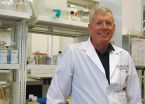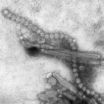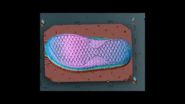In addition, when combined with an adjuvant, which is a chemical that stimulates the immune system to produce more antibodies, a lower dose of the new avian flu vaccine worked better in triggering an immune response than a stronger dose without adjuvant. That means the amount of vaccine against a new strain of bird flu can be stretched to protect more people if an adjuvant is added.
Both findings represent important strategies researchers can continue to study to fight new strains of bird flu that people previously have not been exposed to, and consequently can rapidly turn into a pandemic outbreak and public health emergency, said Robert Belshe, M.D., professor of infectious diseases, allergy and immunology at Saint Louis University and the lead author of the article, which appeared in the Oct. 8, 2014 issue of JAMA.
"This is important because of the need to respond quickly to potential pandemics. We continue to see avian flu as the possible cause of a pandemic virus in the future," Belshe said. "Planning for influenza pandemics is of vital importance, with vaccine being a cornerstone of control efforts."
As bird flu evolves, it could change enough to cross between species and easily spread to people whose have no pre-existing immunity to fight the new flu strain, possibly leading to a global pandemic that could kill millions.
The study, which looked at two H5 influenza vaccines, was conducted at eight clinical sites in the United States and included 637 healthy adults between ages 18 and 49. Some volunteers had previously participated in an earlier study where they received either one or two doses of Vietnam bird flu vaccine. Named for the location where the influenza outbreak originated, the Vietnam vaccine is among the group of medicines and vaccines in a stockpile accumulated by the Centers of Disease Control to protect Americans in case of a public health emergency.
After re-enrolling for this follow up study, participants were given a booster dose of a new, investigational Anhui bird flu vaccine.
"People who had been primed a year ago when they received the Vietnam bird flu vaccine had developed an immunologic memory," Belshe said. "Our findings suggest if a threat of bird flu spreading from person to person was very real, it makes sense to prime with a bird flu vaccine that is related to but does not directly match the circulating strain."
Other volunteers had never previously been vaccinated against bird flu, and this group received various doses of the new Ahnui bird flu vaccine. Two doses of vaccine were required to stimulate an antibody response in the volunteers who had never been vaccinated. When coupled with the immune-system boosting adjuvant, a 7.5 microgram dose of Anhui vaccine was more effective in eliciting an immune response against bird flu, measured as antibody levels in the blood, than the highest dose -- 90 micrograms -- without the adjuvant.
Belshe said that those at high risk of contracting bird flu, such as certain laboratory scientists, field epidemiologists and health care workers in areas with emerging avian influenza, might consider receiving a pre-pandemic vaccine. If bird flu begins to spread rapidly, those workers could then receive a vaccination that matches the pandemic strain, theoretically triggering a quicker immune response.
"Whether priming itself has value in protecting against death is not known, but it is possible that primed individuals would have better outcomes in the face of avian flu infections," Belshe said.
He was clear that while the study provides data to help guide pre-pandemic bird flu vaccine strategies, it is not an efficacy study.
"We do not know what amount of antibodies would be associated with protection from infection, disease or death. Each of these end points might have different correlates of protection," Belshe said.
"The continued drift of H5 avian flu viruses means that the strain of H5 used for the boosting vaccine will need to be updated to keep pace with newer H5 bird flu viruses that emerge. Furthermore, the emergence of H7 avian influenza viruses as human pathogens will require a different priming vaccine than the H5 Vietnam vaccine used in the present study."
Belshe also noted that because the research was limited to healthy young adults, other groups need to be studied, including older adults, adults with underlying chronic conditions, pregnant women and children, since their dose and safety profiles might differ.
INFORMATION:
The research was funded by the National Institutes of Health under National Institute of Allergy and Infectious Diseases-funded contracts to Vaccine and Treatment Evaluation Units. Other authors are Sharon Frey, M.D., Irene Graham, M.D., Edwin Anderson, M.D., division of infectious diseases, allergy and immunology, Saint Louis University, St. Louis; Lisa Jackson, M.D., Group Health Research Institute, Seattle; Paul Spearman, M.D., Emory Children's Center, Atlanta; Srilatha Edupuganti, M.D., Mark Mulligan, M.D., and Nadine Rouphael, M.D., Hope Clinic of Emory University in Atlanta; Patricia Winokur, M.D., University of Iowa Hospitals and Clinics, Iowa City, Iowa; Rowena Dolor, M.D., and Christopher Woods, M.D., and Emmanuel Walter, M.D., Duke Clinical Vaccine Unit, Duke University School of Medicine, Durham, North Carolina; Wilber Chen, M.D., Center for Vaccine Development, University of Maryland School of Medicine, Baltimore; Christine Turley, M.D., University of Texas Medical Branch, Galveston, Texas; Kathyrn Edwards, M.D., and C. Buddy Creech, Vanderbilt Vaccine Research Program, Vanderbilt University Medical Center, Nashville; and Heather Hill and Abbie Bellamy, Ph.D., EMMES Corporation, Rockville, Maryland.
Established in 1836, Saint Louis University School of Medicine has the distinction of awarding the first medical degree west of the Mississippi River. The school educates physicians and biomedical scientists, conducts medical research, and provides health care on a local, national and international level. Research at the school seeks new cures and treatments in five key areas: infectious disease, liver disease, cancer, heart/lung disease, and aging and brain disorders.


